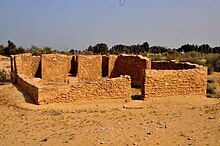Eastern Arabia & the Gulf Coast

Overview
Christianity had become present along the Eastern coast of the Arabian peninsula by the late fourth century, and shows evidence of substantial organization by the fifth century when it first appears in the records of synods being held by the international Christian communities in starting at 410. From then on, bishops and monasteries continue to be mentioned in the Gulf by chronicles, synodic acts, hagiographies and letters all in Syriac records, indicating the presence of many Christian communities in the area. Whereas textual records continue to mention Christian communities until the seventh century, evidence for Christian populations unearthed archaeologically additionally attests to their presence from the seventh to ninth centuries, including churches and monasteries. [49]
Qatar
The Chronicle of Arbela, which appears to date to the sixth century, claims that a bishopric already existed in Beth Qatraye (Syriac-originating term for "territory of the Qataris") around the year 225. However, this is unlikely and the document is considered a forgery by modern specialists. [50]
The first concrete evidence of a highly organized Christian presence in the region of modern-day Qatar is in the description of the synods held at Seleucia-Ctesiphon between 410 and 776, as documented in the eighth-century Synodicon Orientale. The signatory Qatari bishop of this synod was stated to have replaced an earlier bishop, pushing back the date of organized Christianity in this region to the late fourth century. The Synodicon shows that four dioceses existed in the region connected to Persia. The earliest and largest of these dioceses was Mashmahig mentioned at the 410 synod, led by the bishop Elijah (Elias). The last known "bishop and metropolitan of the land of Qaṭar" was named Thomas, who signed his name on the synod in 676. The second largest diocese, Darain was located on the island of Toduro (modern Tarout Island) and was founded during the 410 synod. It was led by the bishop Paul. The third diocese, Hajar, was founded during the Synod of 576 under Bishop Isaac. The 676 synod divided it into two, the Hajar and Hatta dioceses. During this event, Hatta became the fourth and last diocese to be founded in Qatar. Later, Isaac the Syrian (613–700), also known as Isaac of Qatar, would grow up in Qatar before he was ordained and became a monk in Iraq. Other prominent Qatari Christians born in the pre-Islamic period include Gabriel of Qatar, Abraham bar Lipeh, and Ahob of Qatar. [51] [52] [53]
Other literary accounts mention additional monasteries. For example, according to the Life of Jonah, a monastery was constructed on the Black Island between 343–346. [2]
Several Christian sites have been discovered in Qatar and other Gulf countries in recent decades, and they have been dated between the sixth to ninth centuries. Unfortunately, the lack of inscriptions to accompany these discoveries have presented difficulties in dating their remains. [51] [54]
Eastern Saudi Arabia
Discovered in 1986, the Jubail Church is a church found near Jubail in northeastern Arabia and on the Gulf coast of Saudi Arabia. [55] Discoveries of Christian sites have also been made at Jubayl, Thaj, and finally Kilwa, the latter being the only Christian site discovered in eastern Arabia that is not either on an island or directly on the coast. [56] Although some have dated it to the fourth century, more recently, it has been redated to the mid-7th century. [57]
Other Gulf countries
Several additional archaeological findings have been made elsewhere in the Gulf countries. [58] [56] [59] In the mid-seventh century, the Patriarch of the Church of the East, Isho'yahb, sent a letter to Qataris wherein he described the presence of several faithful communities, including Talun, which is a now an island of Bahrain. In Oman, a diocese was established by the name of Bet-Mazunaye in the Synod of 424 under the Bishop John. It was mentioned again at the synods of 544, 576, and 767. [51]
A monastery has been discovered at Sir Bani Yas, an island in the United Arab Emirates. It contains decorative motifs that resemble ones known from Al-Hira in Iraq. [60] [61] Even more impressive is a monastery discovered in al-Quṣur in Failaka Island in Kuwait. A monastery has also been discovered at the Kharg Island in Iran, located 40 km offshore from Bahrain. [51] [62]
The dating of these archaeological sites is contentious. The new dating suggests their construction in the Islamic era, [54] although this view does not presently have unanimous support. [56]









